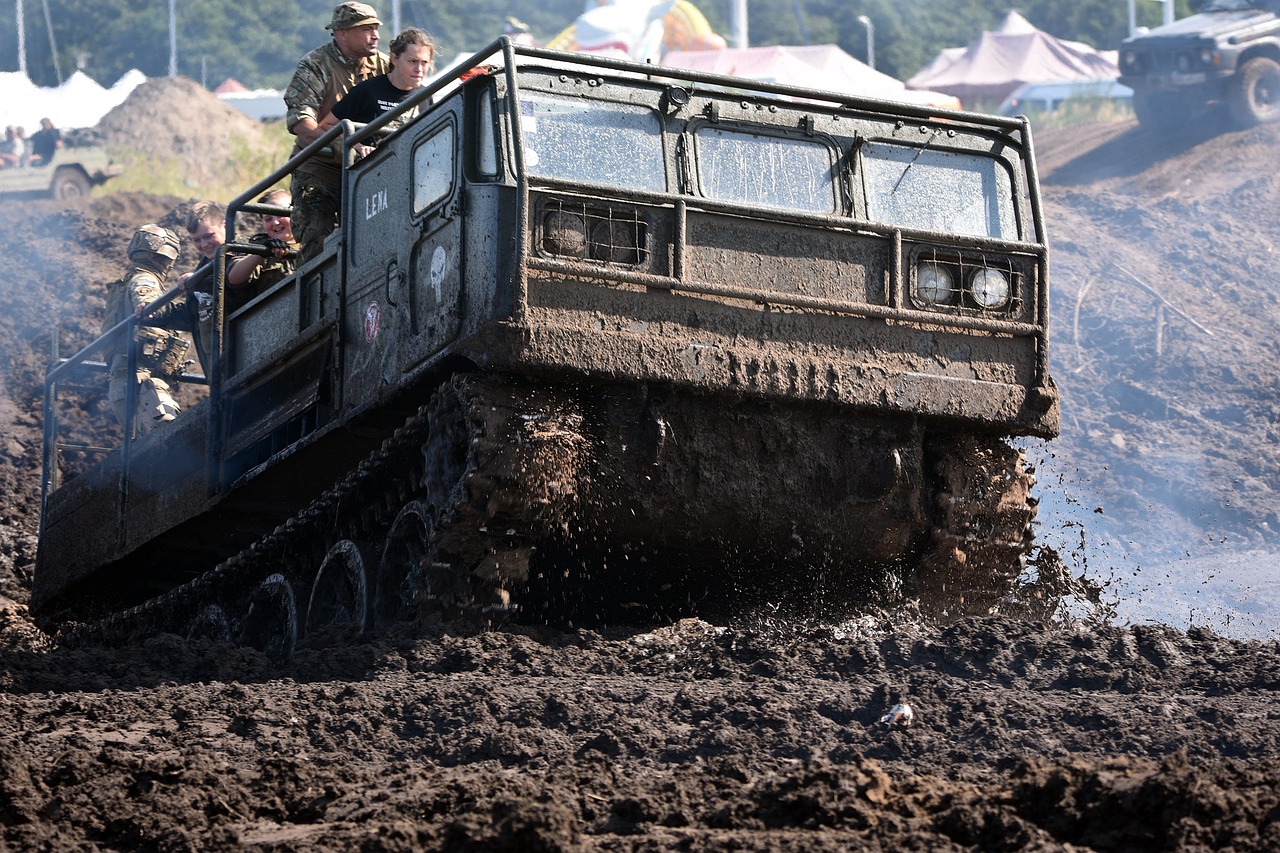Understanding the Importance of Training Simulations in Defense
In today's rapidly changing world, the need for effective military training has never been more critical. Training simulations serve as a cornerstone in preparing defense personnel for real-world scenarios. Imagine stepping into a lifelike battlefield without ever leaving the safety of your base. This is the magic of training simulations, where soldiers can hone their skills, test their strategies, and learn from their mistakes without the dire consequences that come with actual combat. The significance of these simulations extends beyond mere practice; they represent a shift in how we approach military readiness.
As we delve deeper into the realm of training simulations, it becomes clear that they are not just tools but essential components of modern military strategy. They provide a platform for soldiers to engage in realistic training experiences, which are crucial for developing the cognitive and physical skills necessary for success on the battlefield. From virtual environments that mimic hostile territories to constructive simulations that allow for strategic decision-making, the variety of training simulations available today ensures that every aspect of military readiness is addressed.
Moreover, the integration of advanced technologies has transformed these simulations into highly immersive experiences. Think about it: with the advent of virtual reality (VR) and artificial intelligence (AI), training simulations can now replicate complex scenarios that were once unimaginable. Soldiers can face off against AI-driven opponents, navigate intricate terrains, and respond to dynamic situations that evolve in real time. This level of engagement not only enhances learning but also builds confidence, ensuring that when the time comes to face real threats, our troops are more than prepared.
In addition to enhancing skills and confidence, training simulations also contribute to cost-effectiveness in military training. Traditional training methods often require extensive resources, including travel, equipment, and time. In contrast, simulations can be conducted at a fraction of the cost, allowing for more frequent and varied training sessions. This efficiency means that military personnel can spend more time honing their skills and less time worrying about logistics.
However, it's important to recognize that the journey of training simulations is not without its challenges. As with any technology, there are limitations and obstacles that must be addressed. For instance, the need for adaptability among users is paramount; not every soldier is accustomed to high-tech environments, and some may struggle with the transition. Additionally, technological limitations can hinder the realism of simulations, making it essential for developers to continuously innovate and improve. Addressing these challenges is crucial for maximizing the effectiveness of training simulations in defense.
In conclusion, the importance of training simulations in defense cannot be overstated. They are revolutionizing how we prepare our military personnel, providing them with the tools they need to succeed in an increasingly complex world. As technology continues to advance, we can expect training simulations to become even more integral to military strategy, ensuring that our forces are ready for whatever challenges lie ahead.

The Evolution of Training Simulations
Training simulations have come a long way, evolving from rudimentary exercises into sophisticated, technology-driven platforms that provide unparalleled realism and engagement. In the early days, military training relied heavily on traditional methods such as classroom instruction and field drills. These approaches, while effective to some extent, often lacked the immersive quality needed to prepare soldiers for the complexities of modern warfare.
As the world progressed into the digital age, the defense sector began to recognize the potential of advanced technologies. The introduction of computer-based simulations marked a significant turning point. Initially, these simulations were basic, utilizing simple graphics and limited interactivity. However, as technology advanced, so did the capabilities of training simulations. Today, we can create entire virtual worlds that mimic real-life combat scenarios, allowing soldiers to experience a wide range of situations without the inherent risks associated with live training.
One of the most notable advancements in training simulations is the integration of virtual reality (VR) and augmented reality (AR). These technologies have revolutionized how soldiers train by providing immersive environments that can replicate the sights, sounds, and even the emotional stress of combat. Imagine being able to step into a virtual battlefield where you can practice your skills and make decisions in real-time, all while being safely removed from actual danger. This level of engagement not only enhances the learning experience but also prepares soldiers for the unpredictability of real-world operations.
Furthermore, the evolution of training simulations has been driven by the need for cost-effectiveness and resource efficiency. Traditional training methods often require significant expenditures on equipment, travel, and facilities. In contrast, simulations can drastically reduce these costs. For instance, a recent study indicated that military organizations could save up to 50% on training expenses by utilizing simulation technologies instead of conventional methods.
Additionally, training simulations can be tailored to meet specific operational requirements. This customization allows military leaders to design scenarios that reflect current threats and challenges, ensuring that soldiers are not only prepared for the battlefield but also for the unique situations they may encounter. The flexibility afforded by simulations means that training can be conducted at any time and in any location, breaking down geographical barriers that once hindered effective military preparation.
As we look to the future, it's clear that the evolution of training simulations will continue to be shaped by emerging technologies. The integration of artificial intelligence (AI) is expected to further enhance these training platforms, enabling more realistic interactions and adaptive learning experiences. Imagine a training simulation that not only responds to your actions but also learns from them, adjusting scenarios in real-time based on your decision-making patterns. The possibilities are endless, and the impact on military readiness could be profound.

Types of Training Simulations
When it comes to defense training, the methods employed can significantly influence the effectiveness of the preparation. Training simulations come in various forms, each tailored to meet specific training needs. Understanding the types of simulations available is crucial for military organizations seeking to enhance their operational readiness and strategic capabilities. The three primary categories of training simulations are virtual simulations, constructive simulations, and live simulations. Each type offers unique advantages, and their applications can vary widely depending on the training objectives.
Virtual simulations are perhaps the most captivating type of training simulation. Utilizing advanced computer-generated imagery, they create immersive environments that allow soldiers to engage in realistic scenarios without the risks associated with real-world training. Imagine stepping into a digital battlefield where every detail is meticulously crafted to mirror the actual conditions of war; this is the essence of virtual simulations. They not only enhance engagement but also provide a safe space for soldiers to practice complex maneuvers and decision-making under pressure.
On the other hand, constructive simulations employ computer models to replicate military operations. These simulations are less about individual soldier training and more focused on strategic and tactical decision-making. They allow military planners to simulate entire operations, enabling them to assess the effectiveness of different strategies and make informed decisions before actual deployment. By practicing in a simulated environment, commanders can refine their tactics and improve their understanding of battlefield dynamics, ultimately leading to more successful missions.
Lastly, we have live simulations, which involve real troops and equipment in actual field conditions. This type of simulation is often the most challenging to coordinate but can yield incredibly valuable insights. Live simulations provide a tactile, real-world experience that is hard to replicate digitally. However, they also come with higher costs and logistical challenges. The real-time feedback from these exercises can be invaluable, allowing soldiers to learn from their mistakes in a controlled yet realistic setting.
To summarize, the types of training simulations can be categorized as follows:
| Type of Simulation | Description | Advantages |
|---|---|---|
| Virtual Simulations | Computer-generated immersive environments | Cost-effective, safe, realistic scenario replication |
| Constructive Simulations | Computer models for strategic planning | Enhances tactical understanding, decision-making practice |
| Live Simulations | Real troops and equipment in the field | Real-world experience, immediate feedback |
In conclusion, the choice of simulation type can greatly impact the training experience and outcomes for military personnel. By leveraging the strengths of each type, defense organizations can create a comprehensive training program that prepares soldiers for the complexities of modern warfare.

Virtual Simulations
Virtual simulations are revolutionizing the way military personnel train by creating immersive environments that mimic real-world scenarios. Utilizing advanced computer-generated imagery (CGI), these simulations transport soldiers into a digital battlefield where they can practice skills, make decisions, and react to dynamic situations without the inherent risks associated with live training exercises. Imagine stepping into a video game, but instead of just playing for fun, you're honing your tactical skills and teamwork in an environment that feels incredibly real. This blend of technology and training not only enhances engagement but also significantly improves the learning curve for soldiers.
The technology behind virtual simulations is grounded in sophisticated algorithms and high-quality graphics that allow for a variety of scenarios. From urban warfare to aerial combat, virtual simulations can replicate almost any operational environment. The use of virtual reality (VR) headsets and motion tracking systems further enhances this experience, making it possible for soldiers to physically interact with their surroundings. This level of engagement is crucial because it helps to build muscle memory and situational awareness, which are vital during actual missions.
Moreover, the flexibility of virtual simulations means that they can be tailored to meet specific training objectives. Whether it's practicing a new combat technique or conducting a full-scale military operation, these simulations can be adjusted in real-time based on the trainees' performance. This adaptability is a game-changer, as it allows instructors to focus on areas where soldiers may need additional support or practice.
While virtual simulations offer numerous benefits, they also come with their own set of challenges. For instance, the technology must be continuously updated to keep pace with advancements in warfare and ensure that training remains relevant. Additionally, there is a learning curve for both trainers and trainees to effectively use these systems. However, the advantages often outweigh these challenges, making virtual simulations an indispensable tool in modern military training.
In summary, virtual simulations provide a safe, cost-effective, and realistic training environment for military personnel. They enhance operational readiness by allowing soldiers to practice and refine their skills in a controlled setting. As technology continues to evolve, the potential for virtual simulations in defense training will only grow, paving the way for even more innovative and effective training methodologies.

Benefits of Virtual Simulations
Virtual simulations have revolutionized the way military personnel train, providing an array of benefits that enhance the overall effectiveness of defense training programs. One of the most significant advantages is the cost-effectiveness of these simulations. Traditional training methods often require extensive resources, including physical equipment, travel, and personnel costs. In contrast, virtual simulations can be conducted at a fraction of the cost, allowing for more frequent and diverse training opportunities without the financial burden.
Another compelling benefit is enhanced safety. In real-world training scenarios, soldiers are often exposed to potentially dangerous situations. Virtual simulations create a safe environment where personnel can practice high-risk maneuvers without the fear of injury or fatality. This safety aspect encourages soldiers to experiment and learn from their mistakes, ultimately leading to better preparedness in actual combat situations.
Moreover, virtual simulations offer the ability to replicate complex scenarios that may be difficult or impossible to recreate in real life. For instance, soldiers can engage in training exercises that simulate various terrains, weather conditions, and enemy tactics. This level of realism is crucial for developing tactical skills and decision-making abilities, as it prepares soldiers for the unpredictability of real-world operations.
To illustrate the various benefits of virtual simulations, consider the following table that outlines key advantages:
| Benefit | Description |
|---|---|
| Cost-Effectiveness | Reduces training expenses by minimizing the need for physical resources. |
| Safety | Eliminates the risks associated with live training exercises. |
| Complex Scenario Replication | Allows for training in diverse and challenging environments. |
| Immediate Feedback | Provides instant performance assessment and corrective measures. |
Additionally, virtual simulations offer immediate feedback to participants. As soldiers engage in training exercises, they receive real-time assessments of their performance, allowing them to identify areas for improvement quickly. This feedback loop is invaluable for fostering continuous learning and development, ensuring that personnel are always honing their skills and adapting to new challenges.
In summary, the benefits of virtual simulations are multifaceted, combining cost savings, safety, realism, and immediate feedback to create a comprehensive training experience. As technology continues to advance, the potential for even more sophisticated virtual training environments will further enhance military preparedness, ultimately leading to greater operational effectiveness.
- What are virtual simulations? Virtual simulations are computer-generated training environments that allow military personnel to practice various scenarios in a realistic setting.
- How do virtual simulations improve safety? They eliminate the risks associated with live training exercises, allowing soldiers to train without the fear of injury.
- Can virtual simulations replicate real-world scenarios? Yes, they can simulate complex scenarios, including various terrains and enemy tactics, to prepare soldiers for unpredictable situations.
- What kind of feedback do participants receive during virtual simulations? Participants receive immediate performance assessments, enabling them to identify areas for improvement quickly.

Challenges of Virtual Simulations
While virtual simulations have revolutionized military training, they are not without their challenges. One of the most significant hurdles is the technological limitations that can hinder the effectiveness of these training tools. For instance, the hardware and software required for high-quality virtual simulations can be quite expensive, and not all military units may have access to the latest technology. This disparity can lead to a training gap, where some soldiers benefit from advanced simulations while others are left with outdated systems.
Another challenge is the need for user adaptability. Not all personnel are comfortable using advanced technology, and this can create a steep learning curve. Imagine trying to navigate a complex virtual environment while also focusing on tactical maneuvers—it's no easy feat! This adaptability issue can lead to frustration and decreased training effectiveness if not addressed properly.
Furthermore, there is the risk of over-reliance on simulations. While they are invaluable, they cannot fully replicate the unpredictability and chaos of real-world combat scenarios. Relying too heavily on virtual training might give soldiers a false sense of security, as they may not be adequately prepared for the complexities they will face in actual operations. It’s essential to strike a balance between virtual training and real-life exercises to ensure comprehensive preparedness.
Additionally, the integration of simulations into existing training programs can be a logistical nightmare. Coordinating schedules, ensuring all participants are trained on the technology, and maintaining the equipment can be overwhelming. If not managed properly, these factors can lead to wasted resources and reduced training time.
Despite these challenges, the military continues to innovate and adapt. Solutions such as enhanced training programs for personnel, investment in updated technologies, and a balanced approach to training can help mitigate these issues. As we look to the future, addressing these challenges will be crucial for maximizing the potential of virtual simulations in defense training.
- What are virtual simulations? Virtual simulations are computer-generated environments that allow military personnel to practice skills and strategies in a safe, controlled setting.
- What are the main challenges of using virtual simulations in defense? The main challenges include technological limitations, the need for user adaptability, the risk of over-reliance on simulations, and logistical issues in integrating them into training programs.
- How can these challenges be addressed? Solutions may involve enhanced training for users, investment in technology, and a balanced training approach that includes both virtual and real-world scenarios.

Constructive Simulations
Constructive simulations are a fascinating aspect of military training that utilizes computer models to replicate military operations. Imagine a digital battlefield where strategists can maneuver troops, allocate resources, and simulate enemy actions without the risks associated with real-world engagements. These simulations provide a platform for strategic planning and decision-making practice, enhancing a soldier's tactical understanding and readiness.
One of the key features of constructive simulations is their ability to create complex scenarios that mirror real-life challenges faced in the field. By using sophisticated algorithms and models, these simulations allow military personnel to engage in what-if scenarios that can test their decision-making skills under pressure. Whether it’s a simulated ambush or a logistics challenge, the ability to practice these scenarios prepares soldiers for the unexpected, improving their adaptability and response times.
Moreover, constructive simulations serve as a vital tool for collaborative training. Multiple units can engage in a single simulation, allowing for joint exercises that enhance inter-unit coordination. This is particularly crucial in modern warfare, where teamwork and communication can be the difference between success and failure. For instance, during a simulated operation, one unit may be tasked with reconnaissance while another focuses on heavy artillery support. This collaboration fosters a deeper understanding of each unit’s capabilities and limitations, ultimately leading to more cohesive operations in real-life situations.
In addition to enhancing tactical skills, constructive simulations also play a significant role in resource management. Military leaders can practice allocating resources effectively, ensuring that they are prepared for logistical challenges during actual missions. For example, they can simulate supply chain disruptions and practice strategies to mitigate their impacts, thus ensuring that troops are well-equipped and ready for action when the time comes.
However, implementing constructive simulations is not without its challenges. The need for accurate data and the complexity of creating realistic models can be daunting. Furthermore, the success of these simulations heavily relies on the participants' ability to engage with the technology and adapt to the simulated environment. Continuous training on the simulation tools is essential to maximize their effectiveness.
In summary, constructive simulations are an invaluable asset in military training. They not only enhance individual and unit readiness but also improve strategic planning and resource management. As technology continues to advance, we can expect these simulations to become even more sophisticated, providing military personnel with unparalleled training experiences.
- What are constructive simulations? Constructive simulations are computer-based models that replicate military operations, allowing for strategic planning and decision-making practice.
- How do constructive simulations improve military readiness? They provide realistic training scenarios that enhance tactical understanding, resource management, and inter-unit collaboration.
- What challenges do constructive simulations face? Challenges include the need for accurate data, complexity in creating realistic models, and ensuring user adaptability to the technology.

The Impact on Military Preparedness
Training simulations play a crucial role in enhancing military preparedness by providing soldiers with realistic training experiences that closely mimic actual combat scenarios. Imagine stepping into a virtual battlefield where every sound, movement, and decision can mirror real-life situations. This immersive experience not only hones the skills of individual soldiers but also strengthens team dynamics and operational readiness. When troops engage in these simulations, they develop a deeper understanding of their roles and responsibilities, which is essential for success in high-pressure environments.
Moreover, the impact of training simulations extends beyond just individual skill enhancement. They facilitate a comprehensive approach to military training by integrating various aspects of warfare, such as strategy, communication, and tactical execution. For instance, during a simulated mission, soldiers must coordinate with different units, manage resources, and adapt to unexpected challenges. This holistic training method ensures that troops are not only proficient in their specific tasks but also capable of functioning effectively as part of a larger unit.
One of the most significant benefits of training simulations is the ability to evaluate and improve performance continuously. By analyzing data collected during simulations, military leaders can identify strengths and weaknesses within their teams. This data-driven approach allows for tailored training programs that address specific gaps in knowledge or skill sets. Additionally, it enables commanders to make informed decisions about personnel assignments and operational strategies.
Another critical aspect of military preparedness enhanced by training simulations is risk management. Traditional training methods often involve live exercises that can pose safety risks to personnel and equipment. In contrast, simulations provide a safe environment where soldiers can experiment with different tactics and strategies without the fear of real-world consequences. This freedom to explore various scenarios encourages creativity and innovation, ultimately leading to more effective operational plans.
To illustrate the effectiveness of training simulations, consider the following table that compares traditional training methods with simulation-based training:
| Aspect | Traditional Training | Simulation-Based Training |
|---|---|---|
| Cost | Higher due to equipment and location | Lower, as it reduces the need for physical resources |
| Safety | Potentially hazardous | Safe environment for training |
| Realism | Limited by physical constraints | Highly realistic and adaptable scenarios |
| Adaptability | Less flexible in modifying scenarios | Quickly adjustable to meet training needs |
As technology continues to advance, the role of training simulations in military preparedness is expected to grow even more significant. With the integration of artificial intelligence and virtual reality, future simulations will provide even more immersive and realistic training experiences. This evolution will allow military personnel to prepare for a wider range of scenarios, ensuring that they are equipped to handle any situation that may arise on the battlefield.
- What are training simulations?
Training simulations are realistic, interactive environments that allow military personnel to practice skills and tactics in a safe setting. - How do training simulations improve military preparedness?
They enhance individual skills, foster teamwork, and provide a safe space for experimentation, ultimately leading to better operational readiness. - What technologies are used in training simulations?
Technologies such as virtual reality (VR), augmented reality (AR), and artificial intelligence (AI) are commonly utilized to create immersive training experiences. - Are training simulations cost-effective?
Yes, they often reduce costs associated with live training exercises while providing a safe and adaptable training environment.

Measuring Effectiveness
When it comes to assessing the effectiveness of training simulations in defense, the process is both an art and a science. It’s not just about whether soldiers can shoot accurately in a virtual environment; it’s about understanding how these simulations translate into real-world readiness. To truly gauge effectiveness, military organizations utilize a variety of metrics and evaluation methods that encompass both quantitative and qualitative aspects.
One of the primary ways to measure effectiveness is through performance metrics. These metrics often include:
- Skill Acquisition: How quickly and effectively do soldiers learn new skills during simulations?
- Decision-Making Speed: Are trainees able to make split-second decisions under pressure?
- Team Coordination: How well do units work together in simulated scenarios?
Additionally, organizations often conduct after-action reviews (AARs), where participants discuss what went well and what could be improved. This reflective practice not only helps in identifying gaps in training but also fosters a culture of continuous improvement among the troops.
Another critical aspect of measuring effectiveness is through realistic scenario replication. The more closely a simulation mirrors actual combat conditions, the better the training outcomes. For instance, if a simulation can replicate the stress of a battlefield environment — complete with sound effects, visual stimuli, and unpredictable variables — it provides a more accurate assessment of a soldier's readiness. This is where advanced technologies like artificial intelligence and virtual reality come into play, enhancing the realism and complexity of training scenarios.
Furthermore, the impact of simulations can also be assessed through longitudinal studies. By tracking the performance of soldiers over time, trainers can identify trends and correlations between simulation training and operational performance in real missions. Such studies often reveal that soldiers who engage in regular simulation training tend to perform better during actual deployments.
In summary, measuring the effectiveness of training simulations is a multifaceted endeavor that requires a combination of quantitative data, qualitative feedback, and a keen understanding of military objectives. By employing a variety of assessment strategies, defense organizations can ensure that their training simulations are not just engaging, but also effective in preparing soldiers for the realities of combat.
- What are training simulations? Training simulations are controlled environments where military personnel can practice skills, strategies, and decision-making without the risks associated with real-life scenarios.
- How do simulations improve military readiness? Simulations allow soldiers to experience realistic scenarios, enhancing their skills and confidence, which translates to better performance in actual operations.
- What technologies are used in training simulations? Technologies such as virtual reality (VR), augmented reality (AR), and artificial intelligence (AI) are increasingly used to create immersive and adaptive training environments.
- How is the effectiveness of simulations evaluated? Effectiveness is evaluated through performance metrics, after-action reviews, scenario replication, and longitudinal studies tracking soldiers' performance over time.

Future Trends in Training Simulations
The landscape of training simulations in defense is on the brink of a revolution, driven by rapid advancements in technology. As we look to the future, several key trends are emerging that promise to reshape the way military personnel are trained. One of the most significant trends is the integration of artificial intelligence (AI) into training simulations. AI can analyze vast amounts of data, allowing for more personalized training experiences that adapt to the individual needs of soldiers. Imagine a simulation that learns from a soldier's performance and adjusts the difficulty level or scenario complexity in real-time—this is not science fiction, but a future possibility!
Moreover, virtual reality (VR) is set to take immersive training to new heights. With VR headsets becoming more accessible and affordable, military training can become even more engaging and realistic. Soldiers can be placed in lifelike environments that mimic real-world scenarios, from combat situations to humanitarian missions. This level of immersion can significantly enhance decision-making skills and situational awareness.
In addition to AI and VR, the use of augmented reality (AR) is also gaining traction. AR can overlay digital information onto the real world, providing soldiers with crucial data during training exercises. For instance, while navigating a physical training ground, soldiers could see tactical overlays or mission objectives displayed in their field of view, enhancing their operational effectiveness.
Furthermore, the concept of cloud-based training platforms is emerging, allowing for greater collaboration and accessibility. These platforms can host simulations that soldiers can access from anywhere, enabling remote training sessions and joint exercises with international allies. This shift not only saves costs associated with travel and logistics but also fosters a spirit of global cooperation.
As we embrace these technologies, it’s essential to consider the ethical implications and the need for robust cybersecurity measures. With increased reliance on digital platforms, the potential for cyber threats grows. Therefore, military organizations must prioritize security to protect sensitive training data and maintain operational integrity.
In summary, the future of training simulations in defense is bright, filled with possibilities that can enhance military preparedness and effectiveness. The integration of AI, VR, AR, and cloud technologies will not only revolutionize training methodologies but also ensure that soldiers are better equipped to face the challenges of modern warfare. As we move forward, staying ahead of these trends will be crucial for military organizations aiming to maintain a tactical edge.
- What are training simulations? Training simulations are virtual environments used to replicate real-world scenarios for training purposes, allowing military personnel to practice skills and decision-making in a safe setting.
- How do AI and VR enhance training simulations? AI personalizes training experiences based on performance, while VR immerses soldiers in realistic environments, improving engagement and situational awareness.
- What is the role of AR in military training? Augmented reality overlays digital information onto the physical world, providing soldiers with real-time data during training exercises, thus enhancing operational effectiveness.
- Why is cybersecurity important for training simulations? As training simulations become more digital and connected, protecting sensitive data from cyber threats is essential to maintain operational integrity and security.
Frequently Asked Questions
- What are training simulations in defense?
Training simulations in defense are advanced tools that replicate real-world military scenarios, allowing personnel to practice and hone their skills in a safe and controlled environment. These simulations can range from virtual reality experiences to live-action drills, providing a comprehensive training experience.
- How have training simulations evolved over time?
Training simulations have come a long way from simple role-playing exercises to highly sophisticated systems that utilize cutting-edge technologies like virtual reality, artificial intelligence, and complex modeling. This evolution has significantly enhanced realism and engagement, making training more effective than ever.
- What types of training simulations are commonly used?
There are three primary types of training simulations used in defense: virtual simulations, which create immersive environments; constructive simulations, which use computer models for strategic planning; and live simulations, which involve actual troops and equipment in realistic scenarios. Each type has its unique advantages and applications.
- What are the benefits of virtual simulations?
Virtual simulations offer numerous benefits, including cost-effectiveness, enhanced safety, and the ability to recreate complex scenarios that may be difficult or dangerous to practice in real life. They allow soldiers to experience realistic environments without the risks associated with live training.
- What challenges do virtual simulations face?
Despite their advantages, virtual simulations can encounter challenges such as technological limitations, the need for continuous updates, and the requirement for users to adapt to new systems. Addressing these challenges is crucial for maximizing the effectiveness of training.
- How do constructive simulations enhance military readiness?
Constructive simulations enable military personnel to practice decision-making and strategic planning in a risk-free environment. By simulating various operational scenarios, they help improve tactical understanding, enhance readiness, and prepare troops for real-world situations.
- How is the effectiveness of training simulations measured?
The effectiveness of training simulations is assessed using various metrics, including performance outcomes, feedback from participants, and comparisons to real-world training results. Continuous evaluation ensures that simulations meet training goals and improve over time.
- What future trends can we expect in training simulations?
The future of training simulations is likely to be shaped by innovations in technology, particularly the integration of artificial intelligence and virtual reality. These advancements promise to create even more immersive and effective training experiences, transforming military training methodologies.



















